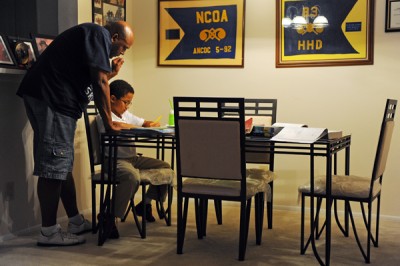Veterans’ Path To College Past Low-Quality, GI Bill Hungry, Predatory Options
By Paul Glader on April 16, 2014
Domestic, Legislation, Regulatory, Required, Retention Rates, Universities & Colleges
CSM Roger Parker, Jr., (US Army-Ret), has returned to college to study Health, Fitness and Nutrition at Anne Arundel Community College. (Photo by Ricky Carioti/The Washington Post)
By Liz Willen, The Hechinger Report
When veterans come home from war and try to put their lives back together, there’s often a giant missing link in their transition: Clear advice on getting back to school and managing the next phase of their education.“Where you are going next is a huge hole in the system, and there is no entity in the community to help them figure out where to start,’’ Pamela Tate, president and CEO of CAEL (Council for Adult and Experiential Learning), said at a hearing on educating veterans in Washington D.C. last week. “They don’t know where they should go to school, what they should study and what careers are there for them.’’A bilateral security agreement between the U.S. and Afghanistan could allow for a lasting presence of troops there through 2024, sending even more veterans into limbo.
That means the road to higher education will remain fraught with challenges for U.S. veterans, some two million men and women who have or will return from Iraq, Afghanistan and elsewhere in the next few years.
It’s a sad state of affairs for a country that educated about 10 million returning veterans after World War II – including three U.S. presidents, three Supreme Court justices, 14 Nobel Prize winners and 24 Pulitzer Prize winners.
The GI bill of 1944 transformed U.S. higher education with benefits allowing veterans to attend any institution that admitted them. The bill helped support spouses and children and offered preparation for vocational careers in construction, auto mechanics and electrical wiring, among others.
In recent years, the revamped Post-9/11 GI bill has provided financial aid to veterans and their families, including reservists and National Guard members – but critics say it does not go far enough to ease the transition home.
“When you leave the military, you are on an island by yourself,’’ said James Selbe, the key advisor for advocacy and support of military, veterans and their family members at University of Maryland University College.
Today’s veterans are having increasing difficulty accessing their benefits, and may end up wandering around campuses looking for someone who can help them transfer credits, register for classes or provide career advice.
Today’s veterans often have difficulty accessing their benefits, and may end up wandering around campuses looking for someone who can help them transfer credits, register for classes or provide career advice. They are not represented at many elite colleges.
Some are finding themselves deep in debt due to predatory lenders; others scammed by for-profit colleges that lure them in – and don’t deliver what they’ve promised. Earlier this month, the Federal Trade Commission warned veterans to be cautious before choosing a for-profit school; at one point some 22 percent of veterans chose the for-profit route.
“They may want to use your Post-9/11 GI Bill benefits to boost their bottom line and may not help you achieve your educations goals,” the commission cautioned.
In California, colleges are finding that benefits don’t go far enough. Campuses are stretched as they try to give veterans the help they need and deserve, said Patrick O’Rourke, director of veteran affairs services for the office of the chancellor at California State University, where the VetNet program provides veteran services and support.
“What we do in California for our veterans comes out of our pockets,’’ O’Rourke said. In a recent visit to centers on two California college campuses, O’Rourke discovered crushing workloads and staff members overwhelmed just trying to connect veterans with simple answers about using their benefits.
Tate, O’Rourke and Selbe of UMUC were among panelists at “Success After Service: Improving Postsecondary Education for Veterans,’’ a discussion that took place in Washington D.C. earlier this month in honor of Veterans Day.
The discussion came some three months after President Barack Obama signed new legislation that asks colleges to boost efforts to help veterans get to and through college. The Lumina Foundation, which is among the various funders of The Hechinger Report, sponsored the panel.
Tate of CAEL said too many veterans don’t know where to go to school, how to get credit for prior learning or work experience and what careers are available to them.
They also often struggle to find answers for their unique range of issues – everything from transferring credits to studying full-time while supporting a family to post-traumatic stress and physical injuries.
What most need is career training that looks at what skills they have – and which ones they need, said Selbe, of UMUC.
“Historically at UMUC they come not to get a job, but to get the next job,’’ Selbe said. “So from a career services perspective that’s where our efforts have been, but with the economy taking a dive and vets coming back in increasing numbers, it has not been the case. We didn’t have the capacity or skill set to let vets navigate their way through.’’
UMUC now trains those who work in career services in the unique needs of veterans, Selbe said – a bright spot in the growing recognition of the continuing obstacles veterans face.
It’s important for hopeful signs to start outnumbering the obstacles – especially as the number of veterans and their families seeking higher education continues to grow.
Here are a few other hopeful signs for veterans and their education:
- Earlier this month, the Google Foundation announced a $3.2 million Global Impact Award to the Institute for Veterans and Military Families, Student Veterans of America, the Posse Foundation and Veterans of Foreign Wars. The grant will support research on which colleges are most successful at supporting veterans and will look at which on-campus programs have the biggest impact.
- More than 250 community colleges and universities in 24 different states and D.C. signed on to Obama’s “8 Keys to Success,’’ program, aimed at helping veterans and military families afford and complete their college degrees, certificates, industry-recognized credentials and licenses and prepare them for jobs.
- Stanford University has found a way to offer veterans additional tuition breaks through its “yellow ribbon,’’ program. So has Columbia University.
- More campuses are recognizing the need to become “veteran friendly,’’ providing rooms, offices or lounges where veterans can gather to share experiences, trade tips and get information. Both the University of Arizona and Rutgers University were recently profiled for their efforts.
- Since 2009, more than one million veterans, service members and their families have received tuition assistance and other benefits from the post-9/11 GI bill.
- Foundations in some cases are stepping in to fill the void. The Robert R. McCormick Foundation, for example, has a new initiative to help Chicago area veterans, as does CAEL.
This story was produced by The Hechinger Report, a non-profit journalism organization housed at Columbia University in New York City.
Related Posts


Tips & Pitches
Latest WA Features
-
Online Courses Are Expanding, Along With Questions About Who Owns The Material
-
Why Size Matters: Consolidation Sweeps Across US Higher Ed
-
Trend: Corporate U Employers Offering Just In Time Education To Workers
-
Subterfuge & Skullduggery In The College Rankings Game
-
“Instreamia” Shakes Loose Moss By Launching Spanish Language Mini-MOOC
Domestic, Education Quality, For-Profit, Friend, Fraud, or Fishy, K-12, Legislation, Opinion, Personalized Learning, Regulatory, Required, Universities & Colleges - Apr 29, 2014 - 0 Comments
Michael Horn: NCAA March Madness Followed By April Blunder In Online Learning
More In For-Profit
- The Economy Is Forcing Tuition To Fall Rapidly At Private, For-Profit Colleges
- Kamenetz: Jeb Bush As Controversial Leader Of Aspen Task Force on Learning & The Internet
- Columnist Ryan Craig: The Best Of Times Could Return As For-Profit Edu Invests
- Bubble Analysis: Trace Urdan on Why This Era of Ed Investing Could Be Different
- A Blended Path? How American Honors Cuts Cost of Four Year Degree by Over a Third
Community Colleges Cost of Education Domestic For-Profit Required Student Loans Universities & Colleges
Cost of Education, Domestic, Education Quality, Friend, Fraud, or Fishy, Opinion, Personalized Learning, Required, Technology, Universities & Colleges - Jan 17, 2014 - 0 Comments
Online Education As A Postmodern Societal Response
More In Technology
- MakerBot Academy: A 3-D Printer In Every Classroom
- Michael Horn: A Look Behind The Curtain At How A MOOC Is Made
- Koller, Khan and Agarwal At The NYT’s Schools of Tomorrow Conference
- Video: New NESTA Report, Three Steps To Assess Digital Innovation in Education
- Norwegian Teens Publish Their Own Guide To Teaching and Learning In Web 2.0
Blended Learning Education Quality International K-12 Open Source Education Personalized Learning Required Technology
Domestic, Education Quality, For-Profit, Friend, Fraud, or Fishy, K-12, Legislation, Opinion, Personalized Learning, Regulatory, Required, Universities & Colleges - Apr 29, 2014 - 0 Comments
Michael Horn: NCAA March Madness Followed By April Blunder In Online Learning
More In Friend, Fraud, or Fishy
- Online Education As A Postmodern Societal Response
- Apple Tightens Its 94% Choke-hold On The Education Tablet Market
- Michael Horn: Why Obama’s Proposals Won’t Entirely Revolutionize HigherEd
- Columnist Ryan Craig: The Curious Case Of HigherEd Accreditation
- McGraw-Hill Executive Speaking About Big Data: “Don’t look at us, look at Joe Camel”
Domestic Ebooks Education Quality Ereaders Ethics Friend, Fraud, or Fishy K-12 Publishers & Curriculum Required Textbooks











Reply